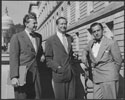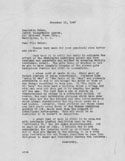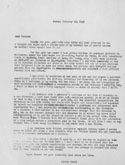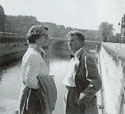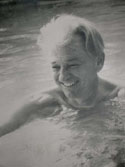Document Archive
From the moment I first discovered this project in the papers of Dore Schary, I have been head over heels in love with my primary sources. While writing my dissertation I often bemoaned the fact that I had to choose the pithiest of supporting or illustrating quotations, when I really wanted to share entire documents with other scholars and especially with students. With the electronic publishing format, I’ve gotten my wish – a digital archive filled with primary sources in all their richness, depth, and complexity.
Though copyright restrictions and licensing fees did impact my choices in minor ways, as a whole this digital archive represents a broad cross-section of documents from my research. Reflecting my staunch belief that the history of a film’s production and reception is crucial in shaping what we see on the screen and how we interpret its meaning and significance for audiences (then and now), I have incorporated as much material as I could to reconstruct the backstory of Scott’s films, including inter-studio memos, correspondence with the Breen Office, Scott’s production notes and public and private writings on the creative process. The promotion and public reception of Scott’s films is also amply documented here. In addition to film reviews representing a variety of perspectives, from the New York Times to the Daily Worker, I have compiled an array of documents that I find particularly exciting and revealing, from the summaries of preview cards submitted by film-goers and the Exhibitors Manual for Crossfire to a provocative series of audience testing materials produced by social scientists and Jewish defense organizations concerned about the public response to an anti-anti-Semitism film.
The archive also contains a rich variety of documents about the history of progressive Hollywood and the industry blacklist. The excerpts from the FBI files of Scott, Dmytryk and Schary are particularly intriguing, enabling glimpses into the activities of the Hollywood left as well as important insights into the workings and internal logic of the FBI and HUAC during World War Two and the Cold War. The internal industry response to the 1947 HUAC hearings is also well represented here. Alongside familiar documents like the statements the Hollywood Ten prepared for the hearings and the Waldorf Statement that instituted the blacklist, you will find more unusual sources. The survey of the public response to the HUAC hearings prepared by Audience Research, Inc., for example, offers a glimpse into the concerns the studio executives. Scott’s notes from his strained meetings with RKO executives following his testimony; his public writings and speeches, and especially his private correspondence trace the road from the hearings to prison to life on the blacklist. In contrast, the FBI file excerpts and especially the Saturday Evening Post article “What Makes a Hollywood Communist?” suggest the complex political pressures and moral challenges faced by those who sought a middle ground between defiance and collusion.
For film clips and even stills, questions of copyright and fair use in this brave new world of digital publishing are still being slugged out. Julie Heath, Executive Director of Clip and Still Licensing at Warner Bros., was very generous with her time and expertise, but also frank in her acknowledgement that the legal department, fearful of setting a precedent, had balked at the broad permission I was seeking. Ultimately, I decided that rather than trying to include just a few seconds worth of film clips or a series of static stills, I would take the chance that that readers and scholars would be intrigued enough to seek out and watch the films in their entirety. Happily, both Murder, My Sweet and Crossfire have been released on DVD and are easily available for rental through Netflix or purchase either singly or as part of multi-film noir collections through Amazon.com. Cornered is somewhat harder to find. Not yet released on DVD (though I recently ran across a Spanish-language version, under the title, Venganza available through Amazon.com), it is screened occasionally on Turner Classic Movies and is available on VHS through Eddie Brandt’s Saturday Matinee (http://www.ebsmvideo.com/), an amazing resource for classic film buffs.
Chapter 1: Reel Reds, Real Americans
Chapter 2: Raising the Cry of Alarm
PDF document:
FBI memo on Edward Dmytryk, March 10, 1951. PDF document: FBI report on Adrian Scott, March 3, 1944. |
Chapter 3: Progressive Producer in the Studio System
Related link: New York Times |
Chapter 4: They Must Not Escape
Chapter 5: You Can't Do That
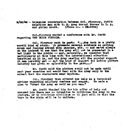 Notes on telephone conversation between Adrian Scott and Colonel Flournoy, U.S. Army Ground Forces, March 19, 1946.
Notes on telephone conversation between Adrian Scott and Colonel Flournoy, U.S. Army Ground Forces, March 19, 1946.Report on Dore Schary, FBI Director J. Edgar Hoover to the Attorney General, November 13, 1947.
Dore Schary to Adrian Scott, c. March 1947.
Chapter 6: It Can Happen Here
Joseph Breen to Harold Melnicker, July 27, 1947.
Adrian Scott to Sol London, June 16, 1947.
Dore Schary to Eleanor Roosevelt, April 26, 1947.
Seymour Peck, "There's New Hope for Hollywood in Dore Schary of 'Crossfire,'" PM, July 22, 1947.
Chapter 7: Is it Good for the Jews?
Dore Schary to Max Horkheimer, April 28, 1947.
Louis E. Raths and Frank N. Trager, "Public Opinion and 'Crossfire,'" Journal of Educational Sociology, 21 (1948).
Elliot E. Cohen, "A Letter to the Movie-Makers: The Film Drama as a Social Force," Commentary 4:2 (August 1947).
Dore Schary, "Letter to Elliot Cohen from a Movie-Maker," Commentary 4:3 (September 1947).
Chapter 8: Hate is Like a Loaded Gun
PDF document: Exhibitors manual for Crossfire, 1947. |
|
Related link: New York Times |
Chapter 9: Americanism on Trial
PDF document: Adrian Scott's statement to HUAC. |
|
PDF document: FBI report on Adrian Scott, June 29, 1949. |
|
PDF document: FBI memo on Dore Schary, January 2, 1951. |
|
Related link: Waldorf Statement |
Chapter 10: The Triumph of Anti-Communist Americanism
PDF document: Adrian Scott speech, March 5, 1948. | |
PDF document: Adrian Scott to Robert Kenny, November 25, 1950. | |
PDF document: FBI memo on Dore Schary, October 29, 1951. |
PDF document: FBI memo on Edward Dmytryk, February 13, 1951. |
PDF document: FBI memo on Edward Dmytryk, April 2, 1951. |
|
PDF document: Adrian Scott to Edward Kook and Sidney Cohen, 1948. |
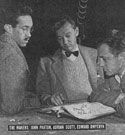
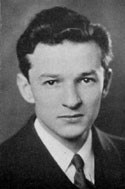

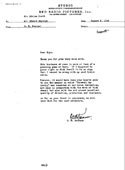
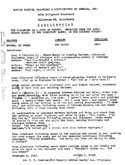
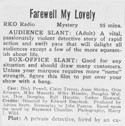
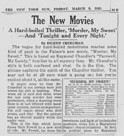

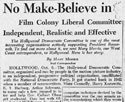

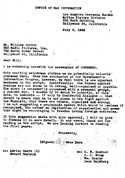

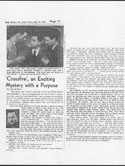

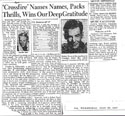
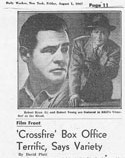

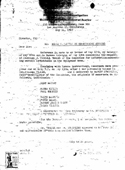
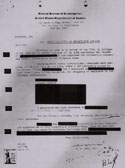
![Cecelia Ager, "Movie Colony's Free Speech Group Practices What It Preaches," [no source or date].](images/thumbnails/c9-8-ager-on-cfa-ns-ndTh.jpg)
